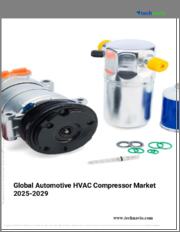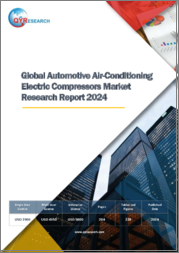
|
시장보고서
상품코드
1611560
자동차용 전동 HVAC 컴프레서 시장 규모, 점유율, 동향 분석 리포트 : 냉각 능력별, 제품별, 차량별, 드라이브트레인별, 지역별, 부문별 예측(2025-2030년)Automotive Electric HVAC Compressor Market Size, Share & Trends Analysis Report By Cooling Capacity, By Product (Scroll), By Vehicle, By Drivetrain (PHEV, BEV, HEV), By Region, And Segment Forecasts, 2025 - 2030 |
||||||
자동차용 전동 HVAC 컴프레서 시장 성장과 동향
Grand View Research, Inc.의 최신 리포트에 따르면 세계의 자동차용 전동 HVAC 컴프레서 시장 규모는 2025-2030년에 23.3%의 CAGR을 기록하며, 2030년에는 531억 1,000만 달러에 달할 것으로 예측됩니다.
전기식 압축기는 기존 압축기에 비해 에너지 소비 감소, 소형화, 회전 속도 제어, 무소음 운전 등 몇 가지 장점이 있습니다. 또한 벨트 구동식 기존 컴프레서와 달리 전기 컴프레서는 차량 엔진과 독립적입니다. 전기 압축기는 인버터를 사용하여 전원을 공급받는 전기 모터에서 전력을 공급받습니다. 이러한 배열은 차량의 전원이 꺼져도 차량의 냉각 작동을 계속할 수 있도록 합니다. 또한 전기식 컴프레서는 구동시 더 적은 전력이 필요하므로 차량 성능에 영향을 미치지 않으며, 오일 이월이 적어 깨끗한 작동을 보장합니다.
전기자동차에서 전기 컴프레서의 기능은 내연기관차의 기존 컴프레서보다 훨씬 더 중요합니다. 전기자동차에서 컴프레서는 배터리 팩뿐만 아니라 차량 내부 전체를 냉각시키는 역할을 합니다. 전기 컴프레서는 배터리 과열로부터 배터리를 보호하고, 나아가 차량의 고장을 방지합니다. 따라서 전기 HVAC 컴프레서는 전기자동차의 전반적인 기능에 필수적인 컴포넌트로 작용합니다. 연료 가격 상승과 환경 보호에 대한 인식이 높아지면서 전기자동차의 보급과 그에 따른 전기 HVAC 컴프레서에 대한 수요가 증가하고 있습니다.
그러나 전기식 HVAC 압축기와 관련된 높은 초기 비용과 유지보수 비용이 시장 성장을 억제할 것으로 예상됩니다. 전기식 HVAC 컴프레서 설치에는 견고한 전기 배선이 필요하며, 이는 전체 시스템 비용을 증가시킵니다. 또한 전기 컴프레서의 수리 및 유지보수는 고급 전문 지식이 필요한 복잡한 작업으로 전체 비용을 증가시키는 요인으로 작용하고 있습니다. 또한 전기 압축기 수요는 모두 전기자동차 수요에 의존하고 있습니다. 그러나 전기자동차 판매는 이미 전기자동차와 관련된 높은 가격과 주행거리 불안이라는 이중고에 직면해 있습니다. 그럼에도 불구하고 기술 발전, 후속 신제품 출시, 전기 충전기 및 충전소의 지속적인 설치로 인해 소비자는 전기자동차를 선택하게 될 것이며, 이는 예측 기간 중 전기 HVAC 압축기에 대한 수요를 촉진할 것으로 예상됩니다.
자동차용 전동식 HVAC 컴프레서 시장 보고서 하이라이트
- 20-40CC 부문은 2024년 54.7%의 점유율을 차지하며 시장을 장악했습니다. 이는 차량 실내 온도를 관리하기 위한 컴팩트하고 효과적인 솔루션을 필요로 하는 승용차 및 소형 상용차에서 효율적인 냉각 시스템에 대한 수요가 증가하고 있기 때문입니다.
- 승용차 부문은 2024년 가장 큰 매출 점유율을 차지하며 시장을 장악했습니다. 이러한 우위는 편안함과 에너지 효율이 높은 개인 소유의 자동차에 대한 소비자의 선호도가 높아진 데 따른 것입니다.
- 자동차용 스크롤 압축기는 자동차용 전기 HVAC 압축기 시장에서 중요한 컴포넌트로, 효율성과 컴팩트한 디자인, 우수한 성능으로 주목받고 있습니다.
- BEV 부문은 환경에 대한 인식이 높아지고 배터리 기술이 발전함에 따라 예측 기간 중 가장 높은 CAGR로 성장할 것으로 예상됩니다.
- 아시아태평양의 자동차 전기 HVAC 컴프레서 시장은 2024년 66.3%의 매출 점유율로 세계 시장을 장악했습니다. 이는 주로 전기자동차(EV)의 급속한 보급과 지속가능한 운송 구상에 대한 정부의 강력한 지원 덕분입니다.
목차
제1장 조사 방법과 범위
제2장 개요
제3장 자동차용 전동 HVAC 컴프레서 시장 변수, 동향, 범위
- 시장 계통 전망
- 시장 역학
- 시장 성장 촉진요인 분석
- 시장 성장 억제요인 분석
- 산업의 과제
- 산업 분석 툴
- PORTER의 산업 분석
- PESTEL 분석
제4장 자동차용 전동 HVAC 컴프레서 시장 : 냉각 능력별, 추정·동향 분석
- 자동차용 전동 HVAC 컴프레서 시장, 냉각 능력별 : 주요 포인트
- 냉각 능력 변동 분석과 시장 점유율, 2024년과 2030년
- 냉각 능력별, 2018-2030년
- 20CC 이하
- 20-40CC
- 40-60CC
- 60CC 이상
제5장 자동차용 전동 HVAC 컴프레서 시장 : 제품별, 추정·동향 분석
- 자동차용 전동 HVAC 컴프레서 시장, 제품별 : 주요 포인트
- 제품 변동 분석과 시장 점유율, 2024년과 2030년
- 제품별, 2018-2030년
- 스크롤
제6장 자동차용 전동 HVAC 컴프레서 시장 : 차량별, 추정·동향 분석
- 자동차용 전동 HVAC 컴프레서 시장, 차량별 : 주요 포인트
- 차량 변동 분석과 시장 점유율, 2024년과 2030년
- 차량별, 2018-2030년
- 승용차
- 소형 상용차
- HCV
- 버스와 장거리 버스
제7장 자동차용 전동 HVAC 컴프레서 시장 : 드라이브트레인별, 추정·동향 분석
- 자동차용 전동 HVAC 컴프레서 시장, 드라이브트레인별 : 주요 포인트
- 드라이브트레인 변동 분석과 시장 점유율, 2024년과 2030년
- 드라이브트레인별, 2018-2030년
- PHEV
- 전기자동차
- 하이브리드
제8장 자동차용 전동 HVAC 컴프레서 시장 : 지역별, 추정·동향 분석
- 자동차용 전동 HVAC 컴프레서 시장 : 지역별 전망
- 지역 시장 : 주요 포인트
- 지역별, 2018-2030년
- 북미
- 미국
- 캐나다
- 유럽
- 영국
- 독일
- 프랑스
- 아시아태평양
- 중국
- 일본
- 인도
- 호주
- 한국
- 라틴아메리카
- 브라질
- 멕시코
- 중동 및 아프리카
- 아랍에미리트
- 사우디아라비아
- 남아프리카공화국
제9장 경쟁 구도
- 기업 분류
- 기업의 시장 포지셔닝
- 기업 히트맵 분석
- 기업 개요/상장기업
- Brose Fahrzeugteile SE &Co. KG
- BorgWarner, Inc
- Denso Corporation
- Hanon Systems
- MAHLE GmbH
- Sanden Corporation
- Toyota Industries Corporation
- Valeo
- Highly Marelli
- Robert Bosch GmbH
Automotive Electric HVAC Compressor Market Growth & Trends:
The global automotive electric HVAC compressor market size is expected to reach USD 53.11 billion by 2030, registering a CAGR of 23.3% from 2025 to 2030, according to a new report by Grand View Research, Inc. An electric compressor offers several benefits over a conventional compressor, such as lower energy consumption, compact size, controlled revolution speed, and noise-free operations. Also, unlike a conventional compressor, which is belt-driven, an electric compressor is independent of the vehicle engine. An electric compressor draws power from a separate electric motor, which is powered using an inverter. Such an arrangement ensures that the cooling operation of the vehicle continues even when the vehicle is turned off. The electric compressor also requires lesser power to drive as a result of this arrangement, thereby leaving the vehicle performance unaffected and ensuring cleaner operations due to low oil carryover.
The function of an electric compressor in an electric vehicle is much significant than that of a conventional compressor in an ICE vehicle. In an electric vehicle, the compressor is responsible for the cooling of the entire cabin as well as the battery pack. Electric compressor protects the battery from overheating and subsequently the vehicle from breaking down. Hence, an electric HVAC compressor serves as an essential component for the overall functioning of an electric vehicle. Rising fuel prices coupled with the growing awareness about environmental protection have been driving the adoption of electric vehicles and subsequently the demand for electric HVAC compressors.
However, the high initial costs and maintenance costs associated with electric HVAC compressors are expected to restrain the growth of the market. The installation of electric HVAC compressors involves heavy-duty electric wiring, which increases the overall cost of the system. Repairs and maintenance of electric compressors is also a complex task requiring a high level of expertise, thereby adding to the overall cost. Moreover, the demand for electric compressors relies entirely on the demand for electric vehicles. However, the sales of electric vehicles are already facing a double whammy of the higher price and range anxiety associated with electric vehicles. Nevertheless, advances in technology, the subsequent launch of new products, and the continued installation of electric chargers and charging stations are expected to encourage consumers to opt for electric vehicles, thereby driving the demand for electric HVAC compressors over the forecast period.
Automotive Electric HVAC Compressor Market Report Highlights:
- The 20-40 CC segment dominated the market with a share of 54.7% in 2024, owing to the increasing demand for efficient cooling systems in passenger and light commercial vehicles, which require compact and effective solutions to manage cabin temperatures.
- The passenger vehicles segment dominated the market with the largest revenue share in 2024. This dominance can be attributed to consumers' growing preference for personal vehicles that offer enhanced comfort and energy efficiency.
- The automotive scroll compressor is a vital component within the automotive electric HVAC compressor market, notable for its efficiency, compact design, and superior performance.
- The BEV segment is expected to grow at the highest CAGR over the forecast period, driven by increasing environmental awareness and advancements in battery technology.
- Asia Pacific automotive electric HVAC compressor market dominated the global market with a revenue share of 66.3% in 2024. This is primarily driven by the rapid adoption of Electric Vehicles (EVs) and robust government support for sustainable transportation initiatives.
Table of Contents
Chapter 1. Methodology and Scope
- 1.1. Market Segmentation and Scope
- 1.2. Market Definition
- 1.3. Information Procurement
- 1.3.1. Purchased Database
- 1.3.2. GVR's Internal Database
- 1.3.3. Secondary Sources and Third-Party Perspectives
- 1.3.4. Primary Research
- 1.4. Information Analysis
- 1.4.1. Data Analysis Models
- 1.5. Market Formulation and Data Visualization
- 1.6. Data Validation and Publishing
Chapter 2. Executive Summary
- 2.1. Market Snapshot
- 2.2. Segment Snapshot
- 2.3. Competitive Landscape Snapshot
Chapter 3. Automotive Electric HVAC Compressor Market Variables, Trends and Scope
- 3.1. Market Lineage Outlook
- 3.2. Market Dynamics
- 3.2.1. Market Driver Analysis
- 3.2.2. Market Restraint Analysis
- 3.2.3. Industry Challenge
- 3.3. Industry Analysis Tools
- 3.3.1. PORTER's Analysis
- 3.3.1.1. Bargaining power of the suppliers
- 3.3.1.2. Bargaining power of the buyers
- 3.3.1.3. Threats of substitution
- 3.3.1.4. Threats from new entrants
- 3.3.1.5. Competitive rivalry
- 3.3.2. PESTEL Analysis
- 3.3.2.1. Political landscape
- 3.3.2.2. Economic and social landscape
- 3.3.2.3. Technological landscape
- 3.3.1. PORTER's Analysis
Chapter 4. Automotive Electric HVAC Compressor Market: Cooling Capacity Estimates and Trend Analysis
- 4.1. Automotive Electric HVAC Compressor Market, By Cooling Capacity: Key Takeaways
- 4.2. Cooling Capacity Movement Analysis and Market Share, 2024 and 2030
- 4.3. Market Estimates and Forecasts, By Cooling Capacity, 2018 - 2030 (USD Million)
- 4.3.1. Less than 20 CC
- 4.3.1.1. Market Revenue Estimates and Forecasts, 2018 - 2030 (USD Million)
- 4.3.2. 20-40 CC
- 4.3.2.1. Market Revenue Estimates and Forecasts, 2018 - 2030(USD Million)
- 4.3.3. 40-60 CC
- 4.3.3.1. Market Revenue Estimates and Forecasts, 2018 - 2030(USD Million)
- 4.3.4. More than 60 CC
- 4.3.4.1. Market Revenue Estimates and Forecasts, 2018 - 2030(USD Million)
- 4.3.1. Less than 20 CC
Chapter 5. Automotive Electric HVAC Compressor Market: Product Estimates and Trend Analysis
- 5.1. Automotive Electric HVAC Compressor Market, By Product: Key Takeaways
- 5.2. Product Movement Analysis and Market Share, 2024 and 2030
- 5.3. Market Estimates and Forecasts, By Product, 2018 - 2030 (USD Million)
- 5.3.1. Scroll
- 5.3.1.1. Market Revenue Estimates and Forecasts, 2018 - 2030 (USD Million)
- 5.3.1. Scroll
Chapter 6. Automotive Electric HVAC Compressor Market: Vehicle Estimates and Trend Analysis
- 6.1. Automotive Electric HVAC Compressor Market, By Vehicle: Key Takeaways
- 6.2. Vehicle Movement Analysis and Market Share, 2024 and 2030
- 6.3. Market Estimates and Forecasts, By Vehicle, 2018 - 2030 (USD Million)
- 6.3.1. Passenger Vehicles
- 6.3.1.1. Market Revenue Estimates and Forecasts, 2018 - 2030 (USD Million)
- 6.3.2. LCV
- 6.3.2.1. Market Revenue Estimates and Forecasts, 2018 - 2030 (USD Million)
- 6.3.3. HCV
- 6.3.3.1. Market Revenue Estimates and Forecasts, 2018 - 2030 (USD Million)
- 6.3.4. Buses and Coaches
- 6.3.4.1. Market Revenue Estimates and Forecasts, 2018 - 2030 (USD Million)
- 6.3.1. Passenger Vehicles
Chapter 7. Automotive Electric HVAC Compressor Market: Drivetrain Estimates and Trend Analysis
- 7.1. Automotive Electric HVAC Compressor Market, By Drivetrain: Key Takeaways
- 7.2. Drivetrain Movement Analysis and Market Share, 2024 and 2030
- 7.3. Market Estimates and Forecasts, By Drivetrain, 2018 - 2030 (USD Million)
- 7.3.1. PHEV
- 7.3.1.1. Market Revenue Estimates and Forecasts, 2018 - 2030 (USD Million)
- 7.3.2. BEV
- 7.3.2.1. Market Revenue Estimates and Forecasts, 2018 - 2030 (USD Million)
- 7.3.3. HEV
- 7.3.3.1. Market Revenue Estimates and Forecasts, 2018 - 2030 (USD Million)
- 7.3.1. PHEV
Chapter 8. Automotive Electric HVAC Compressor Market: Regional Estimates and Trend Analysis
- 8.1. Automotive Electric HVAC Compressor Market: Regional Outlook
- 8.2. Regional Marketplaces: Key Takeaways
- 8.3. Market Estimates and Forecasts, by Region, 2018 - 2030 (USD Million)
- 8.4. North America
- 8.4.1. Market Estimates and Forecasts, 2018 - 2030 (USD Million)
- 8.4.2. U.S.
- 8.4.2.1. Market Estimates and Forecasts, 2018 - 2030 (USD Million)
- 8.4.3. Canada
- 8.4.3.1. Market Estimates and Forecasts, 2018 - 2030 (USD Million)
- 8.5. Europe
- 8.5.1. Market Estimates and Forecasts, 2018 - 2030 (USD Million)
- 8.5.2. UK
- 8.5.2.1. Market Estimates and Forecasts, 2018 - 2030 (USD Million)
- 8.5.3. Germany
- 8.5.3.1. Market Estimates and Forecasts, 2018 - 2030 (USD Million)
- 8.5.4. France
- 8.5.4.1. Market Estimates and Forecasts, 2018 - 2030 (USD Million)
- 8.6. Asia Pacific
- 8.6.1. Market Estimates and Forecasts, 2018 - 2030 (USD Million)
- 8.6.2. China
- 8.6.2.1. Market Estimates and Forecasts, 2018 - 2030 (USD Million)
- 8.6.3. Japan
- 8.6.3.1. Market Estimates and Forecasts, 2018 - 2030 (USD Million)
- 8.6.4. India
- 8.6.4.1. Market Estimates and Forecasts, 2018 - 2030 (USD Million)
- 8.6.5. Australia
- 8.6.5.1. Market Estimates and Forecasts, 2018 - 2030 (USD Million)
- 8.6.6. South Korea
- 8.6.6.1. Market Estimates and Forecasts, 2018 - 2030 (USD Million)
- 8.7. Latin America
- 8.7.1. Market Estimates and Forecasts, 2018 - 2030 (USD Million)
- 8.7.2. Brazil
- 8.7.2.1. Market Estimates and Forecasts, 2018 - 2030 (USD Million)
- 8.7.3. Mexico
- 8.7.3.1. Market Estimates and Forecasts, 2018 - 2030 (USD Million)
- 8.8. Middle East and Africa
- 8.8.1. Market Estimates and Forecasts, 2018 - 2030 (USD Million)
- 8.8.2. UAE
- 8.8.2.1. Market Estimates and Forecasts, 2018 - 2030 (USD Million)
- 8.8.3. Saudi Arabia
- 8.8.3.1. Market Estimates and Forecasts, 2018 - 2030 (USD Million)
- 8.8.4. South Africa
- 8.8.4.1. Market Estimates and Forecasts, 2018 - 2030 (USD Million)
Chapter 9. Competitive Landscape
- 9.1. Company Categorization
- 9.2. Company Market Positioning
- 9.3. Company Heat Map Analysis
- 9.4. Company Profiles/Listing
- 9.4.1. Brose Fahrzeugteile SE & Co. KG
- 9.4.1.1. Company Overview
- 9.4.1.2. Financial Performance
- 9.4.1.3. Cooling Capacity Portfolio
- 9.4.1.4. Recent Developments/ Strategic Initiatives
- 9.4.2. BorgWarner, Inc
- 9.4.2.1. Company Overview
- 9.4.2.2. Financial Performance
- 9.4.2.3. Cooling Capacity Portfolio
- 9.4.2.4. Recent Developments/ Strategic Initiatives
- 9.4.3. Denso Corporation
- 9.4.3.1. Company Overview
- 9.4.3.2. Financial Performance
- 9.4.3.3. Cooling Capacity Portfolio
- 9.4.3.4. Recent Developments/ Strategic Initiatives
- 9.4.4. Hanon Systems
- 9.4.4.1. Company Overview
- 9.4.4.2. Financial Performance
- 9.4.4.3. Cooling Capacity Portfolio
- 9.4.4.4. Recent Developments/ Strategic Initiatives
- 9.4.5. MAHLE GmbH
- 9.4.5.1. Company Overview
- 9.4.5.2. Financial Performance
- 9.4.5.3. Cooling Capacity Portfolio
- 9.4.5.4. Recent Developments/ Strategic Initiatives
- 9.4.6. Sanden Corporation
- 9.4.6.1. Company Overview
- 9.4.6.2. Financial Performance
- 9.4.6.3. Cooling Capacity Portfolio
- 9.4.6.4. Recent Developments/ Strategic Initiatives
- 9.4.7. Toyota Industries Corporation.
- 9.4.7.1. Company Overview
- 9.4.7.2. Financial Performance
- 9.4.7.3. Cooling Capacity Portfolio
- 9.4.7.4. Recent Developments/ Strategic Initiatives
- 9.4.8. Valeo
- 9.4.8.1. Company Overview
- 9.4.8.2. Financial Performance
- 9.4.8.3. Cooling Capacity Portfolio
- 9.4.8.4. Recent Developments/ Strategic Initiatives
- 9.4.9. Highly Marelli
- 9.4.9.1. Company Overview
- 9.4.9.2. Financial Performance
- 9.4.9.3. Cooling Capacity Portfolio
- 9.4.9.4. Recent Developments/ Strategic Initiatives
- 9.4.10. Robert Bosch GmbH.
- 9.4.10.1. Company Overview
- 9.4.10.2. Financial Performance
- 9.4.10.3. Cooling Capacity Portfolio
- 9.4.10.4. Recent Developments/ Strategic Initiatives
- 9.4.1. Brose Fahrzeugteile SE & Co. KG
(주말 및 공휴일 제외)


















